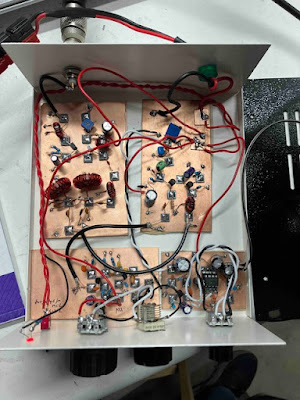Audio: http://soldersmoke.com/soldersmoke251.mp3
Videos: Podcast 251 Aurora! CBLA, Winterfest, Legal Threat, sBITX, SDR, RaspPi, Rounded Passbands, MAILBAG (youtube.com)
Travelouge: Dean goes to the North Pole to see Aurora.
A CBLA Call to Arms!
Winterfest. Lots of goodies. MXM Industries 40 meter transceiver. 1 dollar.
Jean Shepherd. Recording of Bill talking to Shep in 1976.Legal Trouble: Could put us out of operation for a while. We need listener input.
November 2023
December 2023
----------------------Pete's Bench
Homebrew SDR (based on Zl2CTM’s original design) and how good it sounds.
Raspberry Pi Zero W is now working on FT-8 with digital adapter.
Ferrite Cores at Digi-Key (a replacement for the FT-37-43 where you buy 100 and the price is 21 cents/each)
ADE-6 –great specs in HF but more expensive than the ADE-1
For Pete's recent blog posts, go to this site and click on "Archive" in the right column:
https://n6qw.blogspot.com/2024/03/march-31-2924-happy-easter-to-those-who.html
----------------
Dean's Bench
sBITX progress, McGyver-ing a lifted pad, replacing crystal on the CODEC board, sBITX success! See:
https://kk4das.blogspot.com/2024/03/homebrew-sbitx-tx-modules-pa-lpf-and-mic.html
--------------------
Shameless Commerce Division: Please use the Amazon link on the blog to start your Amazon purchases. And please consider using Patreon to support the podcast and blog. We try to send extra content to our Patreon supporters. Mostly DIY RF -- Boards, Kits and Pete's PSSST
---------------------
Bill's Bench
More trouble with the 15-10 rig. Rounded passbands in 25 MHz filter. See figure 4 in both links:
https://www.arrl.org/files/file/QEX_Next_Issue/Nov-Dec_2009/QEX_Nov-Dec_09_Feature.pdf
https://www.networksciences.com/pdfs/tutorial.pdf
Experimenting with Balanced Mixers and Product Detectors. Paul VK3HN Suggests the MC1496 chip; Walter KA4KXX points to SSDRA circuits
But it is on the air! Using the PA from a BITX40 module and an RD06.
Put an OLD dial from Pericles HI8P on 15-10 version 1. Soul in the new machine.
Pericles' Dial on the 15-10 Rig
Mailbag: Grayson KJ7UM's Hollowstate video.
Mike WU2D's amazing 10 meter DSB transceiver.
Jack AI4SV (Dhaka Jack) liked video of recent QSO with AzoresDSB rig
Mike AA1TJ and Dave AA7EE on backwaves and 100 uW QRPpppp
Dave G3UUR on my curved passband problem
Alan W2AEW heard my only QSO with the MXM indsutries SupeRX/TX40
Wes W7ZOI, Mike WN2A, Walter KA4KXX. Farhan VU2ESE on passband,
Ramakrishnan sent article about Charles Proteus Steinmetz. Beautiful.
Justin AC8LV built a receiver! FB.
San Francisco QRP: KDOFNR TouCans Rig, and N6ASD Zinc-Oxide TX
Frank KC8JJL -- Another guy who heard first ham sigs from a homebrew rig.
Nate KA1MUQ's homebrew thermatron superhet
Dino KL0S sent info on the PAL CB VFO I picked up at Winterfest. Airborne!
Bob W8SX will be once again doing SolderSmoke interviews at Dayton. Thanks Bob
Peter VK2EMU Always good to hear from him.
Tobias Feltus -- Wisdom teeth removed, wondering if he will get sBITX hallucinations...
Rick WD5L continues to work on his Herring Aid 5
Ciprian YO6DXE wants to learn CW. No alerts from his FB Blog!
Todd K7TFC -- Likes CW, says it eliminates the Blah-Blah-Blah
F1BFU's Amazing PSSST VFO















































